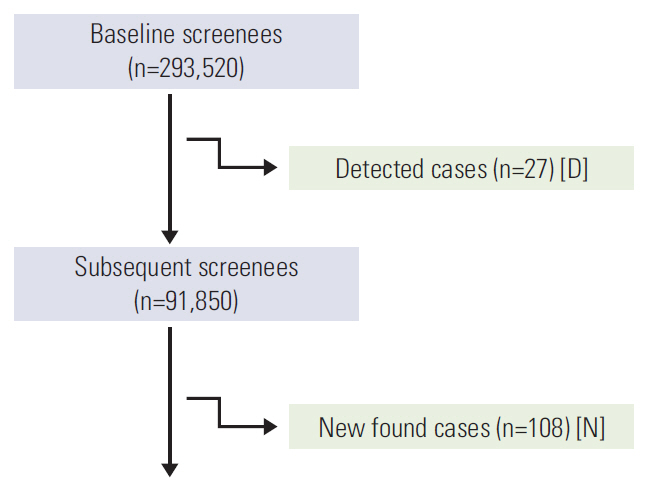Cancer Res Treat.
2015 Oct;47(4):564-568. 10.4143/crt.2014.098.
Optimal Interval for Repeated Gastric Cancer Screening in Normal-Risk Healthy Korean Adults: A Retrospective Cohort Study
- Affiliations
-
- 1Department of Preventive Medicine, Jeju National University School of Medicine, Jeju, Korea. jmbae@jejunu.ac.kr
- 2Korea Medical Institute, Seoul, Korea.
- KMID: 2403372
- DOI: http://doi.org/10.4143/crt.2014.098
Abstract
- PURPOSE
This retrospective cohort study was conducted to estimate the optimal interval for gastric cancer screening in Korean adults with initial negative screening results.
MATERIALS AND METHODS
This study consisted of voluntary Korean screenees aged 40 to 69 years who underwent subsequent screening gastroscopies after testing negative in the baseline screening performed between January 2007 and December 2011. A new case was defined as the presence of gastric cancer cells in biopsy specimens obtained upon gastroscopy. The follow-up periods were calculated during the months between the date of baseline screening gastroscopy and positive findings upon subsequent screenings, stratified by sex and age group. The mean sojourn time (MST) for determining the screening interval was estimated using the prevalence/incidence ratio.
RESULTS
Of the 293,520 voluntary screenees for the gastric cancer screening program, 91,850 (31.29%) underwent subsequent screening gastroscopies between January 2007 and December 2011. The MSTs in men and women were 21.67 months (95% confidence intervals [CI], 17.64 to 26.88 months) and 15.14 months (95% CI, 9.44 to 25.85 months), respectively.
CONCLUSION
These findings suggest that the optimal interval for subsequent gastric screening in both men and women is 24 months, supporting the 2-year interval recommended by the nationwide gastric cancer screening program.
Keyword
MeSH Terms
Figure
Reference
-
References
1. Korea Central Cancer Registry. Annual report of cancer statistics in Korea in 2010 [Internet]. Goyang: National Cancer Center;2013. [cited 2014 Mar 13]. Available from: http://ncc.re.kr/manage/manage03_033_view.jsp?bbsnum=250&hSelSearch=&hTxtKeyword=¤t_page=1&cd=null.2. Hosokawa O, Miyanaga T, Kaizaki Y, Hattori M, Dohden K, Ohta K, et al. Decreased death from gastric cancer by endoscopic screening: association with a population-based cancer registry. Scand J Gastroenterol. 2008; 43:1112–5.
Article3. National Cancer Control Institute. National Cancer Screening Program [Internet]. Goyang: National Cancer Center;[cited 2014 Mar 13]. Available from: http://ncc.re.kr/english/programs/progarms03.jsp.4. Choi KS, Jun JK, Park EC, Park S, Jung KW, Han MA, et al. Performance of different gastric cancer screening methods in Korea: a population-based study. PLoS One. 2012; 7:e50041.
Article5. Riecken B, Pfeiffer R, Ma JL, Jin ML, Li JY, Liu WD, et al. No impact of repeated endoscopic screens on gastric cancer mortality in a prospectively followed Chinese population at high risk. Prev Med. 2002; 34:22–8.
Article6. Mori Y, Arita T, Shimoda K, Yasuda K, Yoshida T, Kitano S. Effect of periodic endoscopy for gastric cancer on early detection and improvement of survival. Gastric Cancer. 2001; 4:132–6.
Article7. Nam SY, Choi IJ, Park KW, Kim CG, Lee JY, Kook MC, et al. Effect of repeated endoscopic screening on the incidence and treatment of gastric cancer in health screenees. Eur J Gastroenterol Hepatol. 2009; 21:855–60.
Article8. Yoon H, Kim N, Lee HS, Shin CM, Park YS, Lee DH, et al. Effect of endoscopic screening at 1-year intervals on the clinicopathologic characteristics and treatment of gastric cancer in South Korea. J Gastroenterol Hepatol. 2012; 27:928–34.
Article9. Shiratori Y, Nakagawa S, Kikuchi A, Ishii M, Ueno M, Miyashita T, et al. Significance of a gastric mass screening survey. Am J Gastroenterol. 1985; 80:831–4.10. Nam JH, Choi IJ, Cho SJ, Kim CG, Jun JK, Choi KS, et al. Association of the interval between endoscopies with gastric cancer stage at diagnosis in a region of high prevalence. Cancer. 2012; 118:4953–60.
Article11. Lee H, Min BH, Lee JH, Son HJ, Kim JJ, Rhee JC, et al. Survival outcome associated with the screening interval for gastric cancer in Korea. Digestion. 2011; 84:142–8.
Article12. Aida K, Yoshikawa H, Mochizuki C, Mori A, Muto S, Fukuda T, et al. Clinicopathological features of gastric cancer detected by endoscopy as part of annual health checkup. J Gastroenterol Hepatol. 2008; 23:632–7.
Article13. Bae JM, Shin SY, Kim EH. Mean sojourn time of preclinical gastric cancer in Korean men: a retrospective observational study. J Prev Med Public Health. 2014; 47:201–5.
Article14. Korea Medical Institute. Nationwide network [Internet]. Seoul: Korea Medical Institute;[cited 2014 Feb 10]. Available from: http://www.kmi.or.kr/kor/center/network/kmi.web.15. American Cancer Society. Diagnosis of stomach cancer: biopsy [Internet]. Atlanta, GA: American Cancer Society;c2014. [cited 2014 Mar 13]. Available from: http://www.cancer.org/cancer/stomachcancer/detailedguide/stomach-cancer-diagnosis.16. Draisma G, van Rosmalen J. A note on the catch-up time method for estimating lead or sojourn time in prostate cancer screening. Stat Med. 2013; 32:3332–41.
Article17. Pashayan N, Duffy SW, Pharoah P, Greenberg D, Donovan J, Martin RM, et al. Mean sojourn time, overdiagnosis, and reduction in advanced stage prostate cancer due to screening with PSA: implications of sojourn time on screening. Br J Cancer. 2009; 100:1198–204.
Article18. Day NE, Walter SD. Simplified models of screening for chronic disease: estimation procedures from mass screening programmes. Biometrics. 1984; 40:1–14.
Article19. Bae JM. Methodological issues for determining intervals of subsequent cancer screening. Epidemiol Health. 2014; 36:e2014010.
Article20. Tabar L, Fagerberg G, Day NE, Duffy SW, Kitchin RM. Breast cancer treatment and natural history: new insights from results of screening. Lancet. 1992; 339:412–4.21. Brenner H, Haug U, Arndt V, Stegmaier C, Altenhofen L, Hoffmeister M. Low risk of colorectal cancer and advanced adenomas more than 10 years after negative colonoscopy. Gastroenterology. 2010; 138:870–6.
Article22. Seo HG. Screening for early detection of cancers II. J Korean Med Assoc. 2006; 49:515–30.
Article23. Shen L, Shan YS, Hu HM, Price TJ, Sirohi B, Yeh KH, et al. Management of gastric cancer in Asia: resource-stratified guidelines. Lancet Oncol. 2013; 14:e535–47.
Article
- Full Text Links
- Actions
-
Cited
- CITED
-
- Close
- Share
- Similar articles
-
- Current status of the gastric cancer screening program in Korea
- Screening for Gastric Cancer: The Usefulness of Endoscopy
- Endoscopic Gastric Cancer Screening and Surveillance in High-Risk Groups
- To Determine the Risk-Based Screening Interval for Diabetic Retinopathy: Development and Validation of Risk Algorithm from a Retrospective Cohort Study
- Screening of gastric cancer


